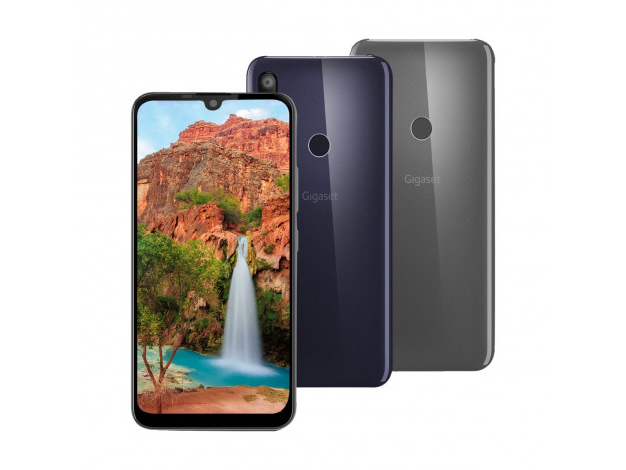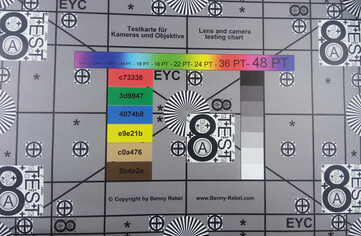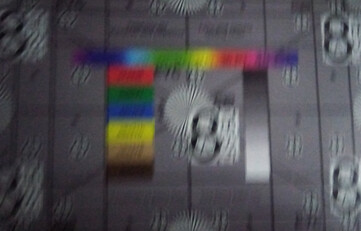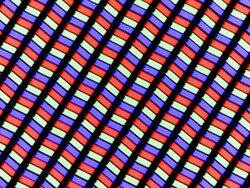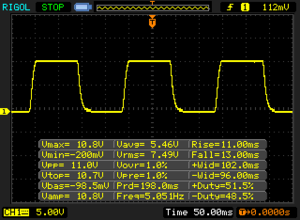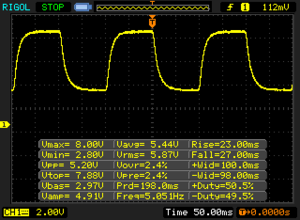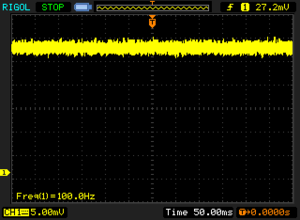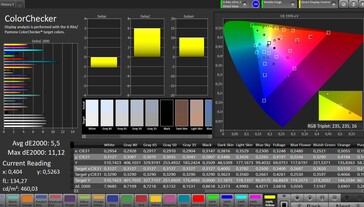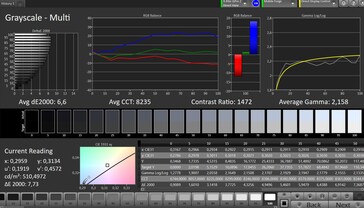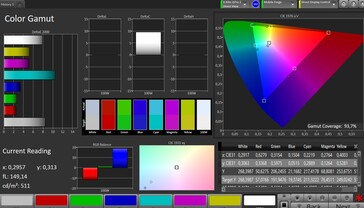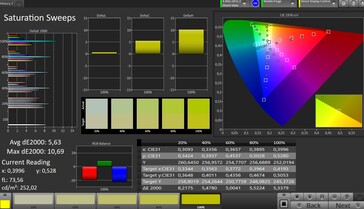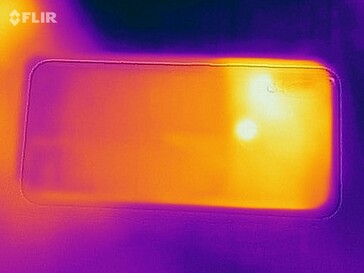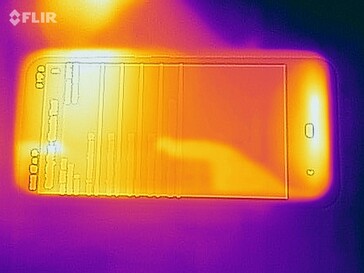Review Gigaset GS190 Smartphone – Too expensive despite large battery?
Vergleichsgeräte
Bewertung | Rating Version | Datum | Modell | Gewicht | Laufwerk | Groesse | Aufloesung | Preis ab |
|---|---|---|---|---|---|---|---|---|
| 70.8 % v7 (old) | v7 (old) | 10 / 2019 | Gigaset GS190 Helio A22 MT6761, PowerVR GE8300 | 172 g | 16 GB eMMC Flash | 6.10" | 1560x720 | |
| 75 % v6 (old) | v6 (old) | 07 / 2018 | Gigaset GS180 MT6737, Mali-T720 MP2 | 150 g | 16 GB eMMC Flash | 5.00" | 1280x720 | |
| 74.9 % v7 (old) | v7 (old) | 08 / 2019 | Samsung Galaxy A10 Exynos 7884B, Mali-G71 MP2 | 168 g | 32 GB eMMC Flash | 6.20" | 1520x720 | |
| 78.8 % v6 (old) | v6 (old) | 06 / 2019 | Nokia 3.2 SD 429, Adreno 504 | 181 g | 16 GB eMMC Flash | 6.26" | 1520x720 |
Case, Equipment and Operation
The GS180 still had a relatively old-fashioned design with wide screen edges, that's history with the GS190: narrow display edges and a small waterdrop notch in which the camera sits are left. The back is made of simple plastic with glittering particles. Available in dark blue or black, the smartphone offers significantly more screen space than the GS180. At 172 grams, the smartphone has also become much heavier. The chassis looks quite stable, but can be easily pressed into the back, which is acceptable in this price range.
LTE is on board, but in our test device only with the most necessary frequencies for Central Europe. VoLTE is supported according to the manufacturer. As far as WiFi is concerned, there is a maximum of WiFi 4, corresponding to the price, here the GS190 proves to be faster than some comparable devices, but not as fast as its predecessor. 16 GB mass storage are scarce, after all you can insert a microSD for memory expansion. For this you have to sacrifice one of the two SIM slots.
The touch screen can be operated properly, but minor delays in operation due to the weak system performance cannot be avoided. The fingerprint sensor on the back reliably unlocks the device.
| Networking | |
| iperf3 transmit AX12 | |
| Gigaset GS180 | |
| Gigaset GS190 | |
| Nokia 3.2 | |
| Samsung Galaxy A10 | |
| iperf3 receive AX12 | |
| Gigaset GS180 | |
| Gigaset GS190 | |
| Samsung Galaxy A10 | |
| Nokia 3.2 | |
Cameras - Almost a Dual-Cam
With a 13-megapixel camera, the Gigaset phone is on a par with similarly expensive devices. The image quality is OK, but sharpness problems become visible in the magnification and very dark and very bright areas quickly lose detail. In dark environments the images quickly become unusable, many details are not recognizable. A 0.3 megapixel camera should help to calculate the depth of field, but it's probably more of an alibi to print a dual camera on the package.
Videos can be recorded with a maximum of 1080p and 30 fps. The light gradients are very roughly graded and an exposure change takes place in clear steps. The image quality in good lighting conditions is OK.
The front camera has a resolution of 8 megapixels, so it offers quite a lot of pixels for the price range.
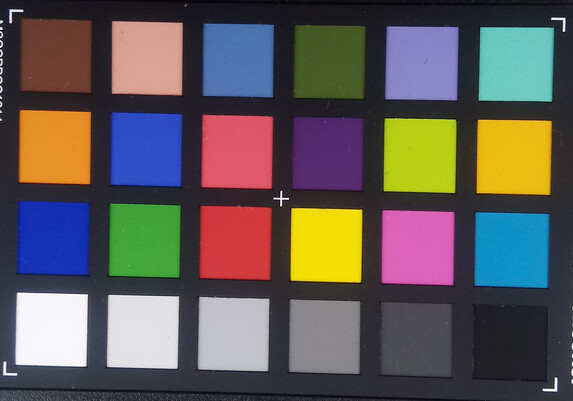
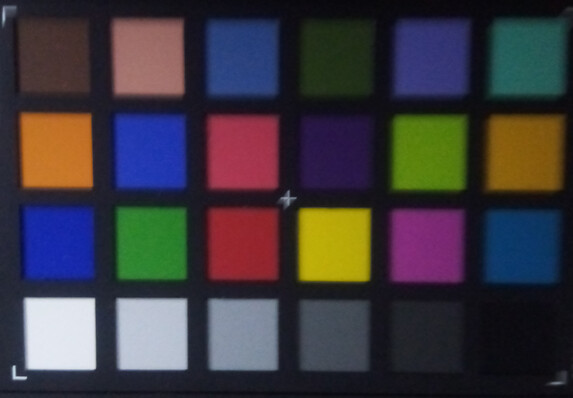
Display - Bright screen in Gigaset mobile phone
The display offers with 720p a usual resolution for the class, in the height a few more pixels are available, because the screen is somewhat narrower and longer than with the comparison devices.
The screen brightness of 489 cd/m² is quite high on average, the black level of 0.34 cd/m² and the contrast are also ok, so that colors on the display appear reasonably strong. The color accuracy is also on a good level. The reaction times are quite high, that becomes especially visible when scrolling.
Our measurements with the software CalMAN and the spectrophotometer show a clear blue cast in the display.
| |||||||||||||||||||||||||
Brightness Distribution: 86 %
Center on Battery: 508 cd/m²
Contrast: 1494:1 (Black: 0.34 cd/m²)
ΔE ColorChecker Calman: 5.5 | ∀{0.5-29.43 Ø4.78}
ΔE Greyscale Calman: 6.6 | ∀{0.09-98 Ø5}
93.7% sRGB (Calman 2D)
Gamma: 2.158
CCT: 8235 K
| Gigaset GS190 IPS, 1560x720, 6.1" | Gigaset GS180 IPS, 1280x720, 5" | Samsung Galaxy A10 IPS, 1520x720, 6.2" | Nokia 3.2 IPS, 1520x720, 6.3" | |
|---|---|---|---|---|
| Response Times | 46% | 29% | 6% | |
| Response Time Grey 50% / Grey 80% * (ms) | 50 ? | 25.6 ? 49% | 38 ? 24% | 40 ? 20% |
| Response Time Black / White * (ms) | 24 ? | 13.6 ? 43% | 16 ? 33% | 26 ? -8% |
| PWM Frequency (Hz) | 100 ? | 77 ? | 1866 ? | |
| Screen | -42% | 4% | -14% | |
| Brightness middle (cd/m²) | 508 | 478 -6% | 451 -11% | 415 -18% |
| Brightness (cd/m²) | 489 | 510 4% | 430 -12% | 391 -20% |
| Brightness Distribution (%) | 86 | 87 1% | 90 5% | 86 0% |
| Black Level * (cd/m²) | 0.34 | 0.9 -165% | 0.22 35% | 0.55 -62% |
| Contrast (:1) | 1494 | 531 -64% | 2050 37% | 755 -49% |
| Colorchecker dE 2000 * | 5.5 | 7.6 -38% | 5.44 1% | 4.8 13% |
| Colorchecker dE 2000 max. * | 11.12 | 13.9 -25% | 11.94 -7% | 9.51 14% |
| Greyscale dE 2000 * | 6.6 | 9.3 -41% | 7.8 -18% | 5.7 14% |
| Gamma | 2.158 102% | 1.98 111% | 2.206 100% | 2.255 98% |
| CCT | 8235 79% | 8003 81% | 9149 71% | 7824 83% |
| Total Average (Program / Settings) | 2% /
-24% | 17% /
9% | -4% /
-10% |
* ... smaller is better
Display Response Times
| ↔ Response Time Black to White | ||
|---|---|---|
| 24 ms ... rise ↗ and fall ↘ combined | ↗ 11 ms rise | |
| ↘ 13 ms fall | ||
| The screen shows good response rates in our tests, but may be too slow for competitive gamers. In comparison, all tested devices range from 0.1 (minimum) to 240 (maximum) ms. » 53 % of all devices are better. This means that the measured response time is worse than the average of all tested devices (20.2 ms). | ||
| ↔ Response Time 50% Grey to 80% Grey | ||
| 50 ms ... rise ↗ and fall ↘ combined | ↗ 23 ms rise | |
| ↘ 27 ms fall | ||
| The screen shows slow response rates in our tests and will be unsatisfactory for gamers. In comparison, all tested devices range from 0.165 (minimum) to 636 (maximum) ms. » 85 % of all devices are better. This means that the measured response time is worse than the average of all tested devices (31.6 ms). | ||
Screen Flickering / PWM (Pulse-Width Modulation)
| Screen flickering / PWM detected | 100 Hz | ≤ 10 % brightness setting | |
The display backlight flickers at 100 Hz (worst case, e.g., utilizing PWM) Flickering detected at a brightness setting of 10 % and below. There should be no flickering or PWM above this brightness setting. The frequency of 100 Hz is very low, so the flickering may cause eyestrain and headaches after extended use. In comparison: 53 % of all tested devices do not use PWM to dim the display. If PWM was detected, an average of 8108 (minimum: 5 - maximum: 343500) Hz was measured. | |||
Performance, Emissions and Battery life
The Gigaset phone comes with the MediaTek Helio A22, a powerful SoC, with which our test device can clearly outperform its predecessor. Other smartphones in the price range are on a similar level. The Galaxy A10 offers significantly more graphics performance. In everyday life, the smartphone is fast enough for most apps, but jerks and waiting times can't be ruled out. Access to the internal memory is slower than with comparable devices.
The smartphone doesn't heat up excessively and even the 40.5 °C that we measure on the upper back is locally limited.
The mono speaker has become significantly quieter compared to its predecessor, but still has a decent volume overall. It sounds a bit height-heavy, but not unpleasant and is therefore suitable for listening to music or film sound. A clean audio signal is transmitted via a 3.5mm connection and Bluetooth.
The GS190's charger has 10 watts of charging power, Gigaset calls this quick charging, we'd say it's a bit faster than older models given the 2.5 hours the smartphone takes to fully charge.
The battery is very large at 4,000 mAh and gives the Gigaset GS190 very good battery life of over 14 hours. However, our test device doesn't come close to the Nokia 3.2, also with a 4,000 mAh battery. Two working days without charging the battery shouldn't be a problem with our test device, but if you don't use your smartphone much, you might only need one charge every 5 days.
Unlike its predecessor, the battery is non-removable.
| PCMark for Android | |
| Work performance score (sort by value) | |
| Gigaset GS190 | |
| Gigaset GS180 | |
| Samsung Galaxy A10 | |
| Nokia 3.2 | |
| Average Mediatek Helio A22 MT6761 (4229 - 7216, n=9) | |
| Work 2.0 performance score (sort by value) | |
| Gigaset GS190 | |
| Gigaset GS180 | |
| Samsung Galaxy A10 | |
| Nokia 3.2 | |
| Average Mediatek Helio A22 MT6761 (4195 - 5511, n=11) | |
| Gigaset GS190 | Gigaset GS180 | Samsung Galaxy A10 | Nokia 3.2 | Average 16 GB eMMC Flash | Average of class Smartphone | |
|---|---|---|---|---|---|---|
| AndroBench 3-5 | 27% | 100% | 89% | -3% | 3414% | |
| Sequential Read 256KB (MB/s) | 201.2 | 154.1 -23% | 296.4 47% | 282.4 40% | 164.5 ? -18% | 2228 ? 1007% |
| Sequential Write 256KB (MB/s) | 35.5 | 67.3 90% | 101.7 186% | 106.3 199% | 43 ? 21% | 1851 ? 5114% |
| Random Read 4KB (MB/s) | 23.6 | 12.5 -47% | 73.4 211% | 35 48% | 21.7 ? -8% | 296 ? 1154% |
| Random Write 4KB (MB/s) | 5.2 | 9.73 87% | 13.3 156% | 17.5 237% | 8.08 ? 55% | 337 ? 6381% |
| Sequential Read 256KB SDCard (MB/s) | 83.3 ? | 78.8 ? -5% | 87.2 ? 5% | 59.1 ? -29% | ||
| Sequential Write 256KB SDCard (MB/s) | 64.1 ? | 65.3 ? 2% | 65.7 ? 2% | 39.8 ? -38% |
Temperature
(+) The maximum temperature on the upper side is 37.9 °C / 100 F, compared to the average of 35.2 °C / 95 F, ranging from 21.9 to 247 °C for the class Smartphone.
(±) The bottom heats up to a maximum of 40.5 °C / 105 F, compared to the average of 34 °C / 93 F
(+) In idle usage, the average temperature for the upper side is 28.3 °C / 83 F, compared to the device average of 32.9 °C / 91 F.
Loudspeakers
Gigaset GS190 audio analysis
(+) | speakers can play relatively loud (82.7 dB)
Bass 100 - 315 Hz
(-) | nearly no bass - on average 66.9% lower than median
(+) | bass is linear (0% delta to prev. frequency)
Mids 400 - 2000 Hz
(-) | nearly no mids - on average 66.9% lower than median
(+) | mids are linear (0% delta to prev. frequency)
Highs 2 - 16 kHz
(-) | nearly no highs - on average 66.9% lower than median
(+) | highs are linear (0% delta to prev. frequency)
Overall 100 - 16.000 Hz
(-) | overall sound is not linear (122.7% difference to median)
Compared to same class
» 91% of all tested devices in this class were better, 7% similar, 2% worse
» The best had a delta of 11%, average was 35%, worst was 134%
Compared to all devices tested
» 97% of all tested devices were better, 2% similar, 1% worse
» The best had a delta of 4%, average was 24%, worst was 134%
Gigaset GS180 audio analysis
(+) | speakers can play relatively loud (88.4 dB)
Bass 100 - 315 Hz
(-) | nearly no bass - on average 32.3% lower than median
(±) | linearity of bass is average (8.4% delta to prev. frequency)
Mids 400 - 2000 Hz
(+) | balanced mids - only 3.1% away from median
(+) | mids are linear (4.6% delta to prev. frequency)
Highs 2 - 16 kHz
(+) | balanced highs - only 4.3% away from median
(+) | highs are linear (4.5% delta to prev. frequency)
Overall 100 - 16.000 Hz
(±) | linearity of overall sound is average (19.8% difference to median)
Compared to same class
» 31% of all tested devices in this class were better, 8% similar, 61% worse
» The best had a delta of 11%, average was 35%, worst was 134%
Compared to all devices tested
» 50% of all tested devices were better, 7% similar, 43% worse
» The best had a delta of 4%, average was 24%, worst was 134%
Battery life
| Gigaset GS190 4000 mAh | Gigaset GS180 3000 mAh | Samsung Galaxy A10 3400 mAh | Nokia 3.2 4000 mAh | Average of class Smartphone | |
|---|---|---|---|---|---|
| Battery Runtime | |||||
| WiFi Websurfing (h) | 14.1 | 8.3 -41% | 12.6 -11% | 16 13% | 19.3 ? 37% |
Pros
Cons
Verdict - Lots of term for comparatively a lot of money
At 170 euros, the Gigaset GS190 is noticeably more expensive than comparable devices; the main argument for this is probably the large battery. This actually results in long battery life, but also quite a long charging time. The screen is quite bright, but unevenly illuminated. The WLAN is actually a bit faster than other devices in the price range and the chic and stable case has a modern design with waterdrop notch and a lot of screen space.
The display pleases with its brightness and quite strong colours, but it is unevenly illuminated. The camera is at class level, which means OK for snapshots. But those who only have slightly higher demands should look around at least one class higher.
The Gigaset GS190 is a bit expensive, but also offers long battery life and a bright screen.
If the price of the Gigaset GS190 continues to drop, it could well be a recommendation, as it brings a very solid smartphone with long battery life into your home.
Gigaset GS190
- 10/25/2019 v7 (old)
Florian Schmitt




